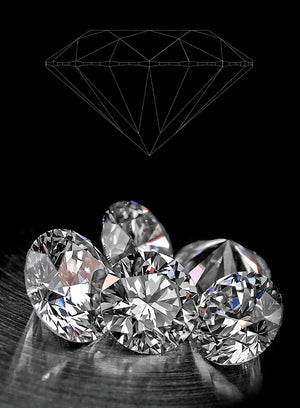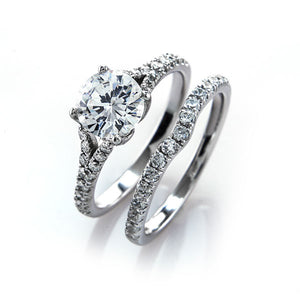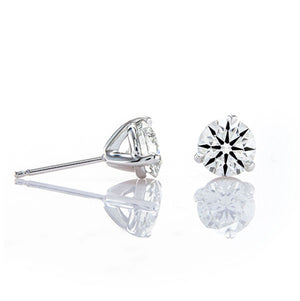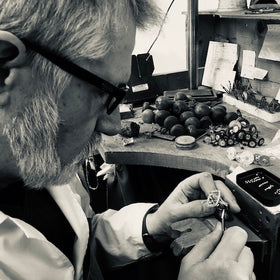
Discover the Brilliance of Fancy Colored Lab Diamonds
A touch of color makes a significant impact, which holds particularly true in lab-grown diamonds. When it comes to good lab-grown diamonds, the allure of fancy colors adds a new dimension to the gem’s aesthetic. A unique color is a bold statement that captivates the eyes and affects the lab-grown diamond's value.
This is your ultimate guide to lab-grown fancy colored diamonds. The traditional 4 diamond Cs are important, but the color is often overshadowed by how big or how clear the diamond is.
Without further adieu, let’s dive into the fascinating world of lab-grown colored diamonds and discover how color adds personality to the gem. We’ll learn all there is to know about the creation process, available colors, and the intricacies of grading.
Can Fancy Color Diamonds Be Lab-Grown?
Diamond-growing technology continues to make amazing headway. Advanced techniques are capable of producing fancy color lab-grown diamonds, allowing for precision in creating an extensive spectrum of hues.
From deep blues reminiscent of the ocean to delicate pinks akin to the shades of a sunset, the possibilities for unique and vibrant gems have expanded exponentially. Lab-grown diamonds have a wider range of colors than even moissanite or simulated diamonds.
By introducing specific elements during the growth process, scientists and gemologists can meticulously craft diamonds with an array of colors once considered rare or even unattainable in the past.
The ability to add elements into a diamond's growing phase has set the gems apart. This level of precision and control ensures a diverse and stunning palette and empowers consumers to choose lab diamonds that align with their individual tastes and preferences.
How Are Colored Lab Diamonds Made?
Lab-grown colored diamonds are created using advanced methods such as HPHT (High Pressure and High Temperature) and CVD (Chemical Vapor Deposition). Both HPHT and CVD methods operate in controlled environments, allowing for the introduction of specific elements that impart stunning colors to the diamonds.
HPHT involves subjecting carbon (usually in the form of a diamond seed) to high pressure and high temperature. It can be used to enhance or introduce colors to lab-created diamonds. Colored lab diamonds with a faint or undesirable color can be subjected to HPHT to improve their color grade. This is achieved by annealing or modifying the crystal lattice structure of the diamond.
Trace elements or other substances are added to the diamond growth environment to introduce specific colors to diamonds during growth. For example, adding nitrogen can produce yellow or orange hues, while boron produces blue diamonds.
What Colors are Available?
In typical lighting, diamonds often appear colorless to the naked eye, leading many consumers to believe all diamonds lack color. When examined closely, diamonds reveal their true spectrum, exhibiting diverse hues and challenging the common misconception of uniform colorlessness.
There is a vast spectrum of available colors for lab-grown diamonds including blues, pinks, yellows, greens, and oranges. Each color is a testament to the precision and artistry of the lab-grown diamond growing process.
This diverse range of colors is a celebration of scientific innovation and an embodiment of the creative possibilities inherent in lab-grown diamonds.
Which Color is Best for Lab-Grown Diamonds?
Everyone has a unique taste. Deciding on the “best” color for lab-grown diamonds is impossible. The best color for a lab-grown diamond is subjective and depends on personal preferences.
When selecting the best color for lab-grown diamonds, it's essential to distinguish between traditional white diamonds and fancy colored diamonds. White diamonds are graded on a color scale from D (colorless) to Z (light yellow or brown), with the most sought-after being near-colorless grades like D, E, and F. This scale measures the absence of color, with truly colorless diamonds considered the rarest and most valuable.
However, for fancy colored diamonds the presence and intensity of color are the defining factors. The appeal of fancy colored diamonds lies in their vibrant hues, ranging from vivid blues and pinks to intense yellows and greens. Instead of striving for a lack of color, these diamonds are prized for their bold, eye-catching shades.
One size does not fit all. Since color preferences vary from person to person, there is no single “best” color for lab-grown diamonds. The ideal choice is entirely subjective and reflects individual tastes and styles. While some may prefer the classic elegance of a near-colorless white diamond, others might be drawn to the striking individuality of a fancy colored gem. Customization is key. The beauty of lab-grown diamonds is that every gem has a unique set of characteristics, whether it’s a pristine white diamond or a stunning fancy colored one. These features breathe life into a diamond and give it personality, allowing consumers to find the perfect stone that reflects their style and taste.
Colored Lab Diamonds Grading
When grading lab-grown diamonds, it's essential to distinguish between the methods used for traditional white diamonds (graded D to Z) and fancy colored diamonds. Each type requires a unique approach to accurately assess its color characteristics.
Grading Diamonds in the D to Z Color Range:
Diamond Grading Color Scale:
-
D: Completely colorless; the highest grade and most valuable.
-
E-F: Colorless; slight traces of color detectable only by expert gemologists.
-
G-J: Near colorless; slight color detectable but still considered high quality.
-
K-M: Faint yellow or brown; noticeable color, yet still attractive.
-
N-R: Very light yellow or brown; more noticeable color.
-
S-Z: Light yellow or brown; the color is more apparent and generally less desirable.
Diamond Grading Process:
-
Grading is conducted under standardized lighting conditions using a master set of comparison stones.
-
The diamond is observed face down through its pavilion (bottom half) and compared to the master stones to determine its color grade.
-
Higher color grades are assigned to diamonds that appear "whiter."
Grading Fancy Color Diamonds:
Fancy Color Diamond Scale:
Fancy colored diamonds are graded based on the intensity and hue of their color rather than the absence of color. The Gemological Institute of America (GIA) uses the following scale:
-
Faint
-
Very Light
-
Light
-
Fancy Light
-
Fancy
-
Fancy Intense
-
Fancy Vivid
-
Fancy Dark
-
Fancy Deep
Key components of fancy color grading include:
-
Hue: The basic color of the diamond (e.g., yellow, pink, blue, green).
-
Tone: The lightness or darkness of the color.
-
Saturation: The strength or intensity of the color.
Grading Process:
-
Fancy colored diamonds are evaluated face-up to determine how the color appears from the top view of the diamond.
-
Graders assess the evenness and distribution of color throughout the diamond.
-
The color grade is determined by comparing the diamond to a set of master stones with known color grades.
Key Differences Between White Diamond and Color Diamond Grading:
Color Presence:
-
D to Z diamonds are graded based on the lack of color.
-
Fancy color diamonds are graded based on the presence and intensity of color.
Grading Criteria:
-
D to Z diamonds focus on how colorless the diamond is.
-
Fancy color diamonds emphasize the vividness and saturation of the color.
The 4 + 1 Cs
Understanding the 4 Cs - cut/shape, color, clarity, and carat weight - remains important when evaluating the quality of colored lab diamonds.
At Brian Gavin, we understand the significance of the 4 Cs, but we add another C, cut/performance, to create the 5 Cs of lab diamond grading. This added dimension highlights the role of precise cutting in enhancing a diamond's light performance, which influences brilliance, sparkle, and scintillation.
For fancy colored diamonds, an optimal cut can amplify the stone's natural hues, bringing out the subtleties of its color and making the diamond even more striking.
Optimal diamond cutting is paramount to unlocking maximum light performance, which affects brilliance, sparkle, and scintillation. The precision of a cut can help bring out the subtle nuances of fancy color, making a diamond truly special and unique.
Emphasizing cut performance showcases the precision craftsmanship and attention to detail that distinguish Brian Gavin lab-grown diamonds from the rest.
How to Use a Lab-Grown Diamond Color Chart?
A color chart is a visual reference tool used to assess the color grade of a diamond. It typically consists of a range of master stones representing various colors. Gemologists use these charts to compare and determine the color of a diamond. The color scale usually ranges from D (colorless) to Z (light yellow or brown).
For colored diamonds, different charts or scales may be used to evaluate the intensity and hue of the diamond's color. Overall, the color chart serves as a standardized method to ensure consistency in grading and describing the color of diamonds.
Reading a lab-grown diamond color chart involves looking at various color grades and choosing a hue that resonates with personal taste. The chart is a visual roadmap to help you pick the perfect color to match your preference.
Are Colored Lab Diamonds More Expensive?
The pricing of colored lab diamonds varies based on color intensity, and market demand. While some colors may command higher prices, lab-grown diamonds offer more affordable options. Purchasing spectacular stones is one of the many advantages of lab-grown diamonds.
Choosing your favorite color without breaking the bank makes lab diamonds a choice that grows more and more popular each year.
Buying Fancy Colored Lab Diamonds
Consider reputable jewelers and review lab-grown diamond certification when purchasing lab-created fancy diamonds online. Explore various shapes and cuts. Brian Gavin’s lab diamond collection includes lab diamond engagement rings and preset lab diamond jewelry. We are one of the best places to buy lab-grown diamonds online.
















